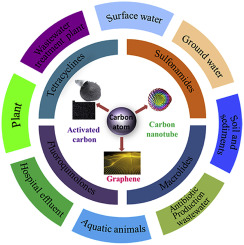ABSTRACT: Antibiotics, an important type of environmental contamination, have attracted many researchers to the study of their removal from aqueous solutions. Adsorption technology is a fast, efficient, and economical physicochemical method that is extensively used in wastewater treatment. From original activated carbon and carbon nanotubes to the latest graphene-based materials, carbon-based materials have been widely used as highly effective adsorbents for contaminant removal from aqueous solution because of their large specific surface area, high porosity, and high reaction activity. In this article, adsorption removal methods for four major types of antibiotic (tetracyclines, sulfonamides, macrolides, and quinolones) are reviewed. We also provide an overview of the application development of carbon materials as adsorbents for antibiotic removal from aqueous solution. The most promising works are discussed, and the main challenges in preparing high-performance adsorbents and the development tendency of adsorbents are also analyzed. This work provides theoretical guidance for subsequent research in the design and modification of carbon materials for applications in the adsorption removal of antibiotics from aqueous solution.
